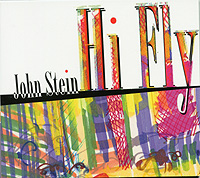 Headed
up by music impresario Neal Weiss, Whaling City Sound is one
of the finest independent American jazz labels. For musicians and
music fans who've followed WCS for years, it’s clear the Whaling
City Sound label is a great source for instrumental modern and mainstream
jazz. One of the label’s most inventive guitarists, John Stein
returns in 2011 with the CD release of Hi Fly. On
the “fly” usually refers to something that happens off the
cuff or kind of unpremeditated, yet Stein’s Hi Fly is
a solid, and well thought out set of jazzy, groove-based guitar instrumentals.
What’s readily apparent on the ten track, 57 minute Hi Fly
is just how well Stein interacts with his band—Jake Sherman
(piano, organ), John Lockwood (acoustic bass) and Zé
Eduardo Nazario (drums). The CD cover art and packaging is quite
colorful too and in depth liner notes—written by Wayne Everett
Goins—testifies to Stein’s overall satisfaction at the
way the Hi Fly CD turned out. Commenting on the CD, Stein adds,
‘The main thing, is the collaborative spirit in this record.
The guys contributed a lot of musical ideas. Their instrumental virtuosity
was challenging and I really stretched to keep up.’ Recorded
in 2011, the Hi Fly CD was superbly engineered by Peter
Kontrimas, sealing the deal on Stein’s finest guitar statement
yet. www.WhalingCitySound.com
Headed
up by music impresario Neal Weiss, Whaling City Sound is one
of the finest independent American jazz labels. For musicians and
music fans who've followed WCS for years, it’s clear the Whaling
City Sound label is a great source for instrumental modern and mainstream
jazz. One of the label’s most inventive guitarists, John Stein
returns in 2011 with the CD release of Hi Fly. On
the “fly” usually refers to something that happens off the
cuff or kind of unpremeditated, yet Stein’s Hi Fly is
a solid, and well thought out set of jazzy, groove-based guitar instrumentals.
What’s readily apparent on the ten track, 57 minute Hi Fly
is just how well Stein interacts with his band—Jake Sherman
(piano, organ), John Lockwood (acoustic bass) and Zé
Eduardo Nazario (drums). The CD cover art and packaging is quite
colorful too and in depth liner notes—written by Wayne Everett
Goins—testifies to Stein’s overall satisfaction at the
way the Hi Fly CD turned out. Commenting on the CD, Stein adds,
‘The main thing, is the collaborative spirit in this record.
The guys contributed a lot of musical ideas. Their instrumental virtuosity
was challenging and I really stretched to keep up.’ Recorded
in 2011, the Hi Fly CD was superbly engineered by Peter
Kontrimas, sealing the deal on Stein’s finest guitar statement
yet. www.WhalingCitySound.com
mwe3.com
presents an interview with
JOHN STEIN
mwe3: The new Hi Fly CD is your best yet. How would
you say it represents the height of your guitar career?
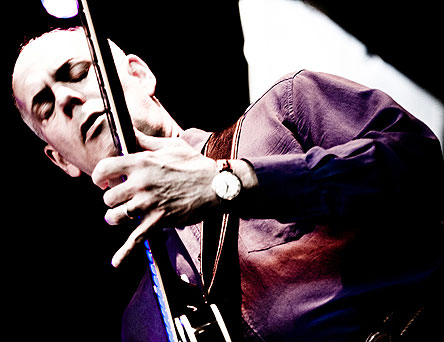 JOHN STEIN:
First of all, it pleases me that you really like my new recording.
I put a lot of time and effort into my musicianship and it’s
very nice to be appreciated. The Hi Fly CD is my most
recent tangible project, so perhaps it represents the current state
of my musical progress more clearly than my earlier recordings. I
love the fact that music is a challenging art form. Every experience
adds something to my understanding, and I bring my accumulated wisdom
to each new project.
JOHN STEIN:
First of all, it pleases me that you really like my new recording.
I put a lot of time and effort into my musicianship and it’s
very nice to be appreciated. The Hi Fly CD is my most
recent tangible project, so perhaps it represents the current state
of my musical progress more clearly than my earlier recordings. I
love the fact that music is a challenging art form. Every experience
adds something to my understanding, and I bring my accumulated wisdom
to each new project.
mwe3: You were born in Kansas City. What was it like growing up in
Missouri and how did the guitar impact your life early on?
JS: I began to play guitar as a 7 year old. I was fortunate to have
a wonderful teacher. Her name was Charlene Kunitz, and she mentored
me until she moved with her husband to California when I was 11 or
12 years old. Charlene was primarily a folk singer and guitarist at
that time, although she had a background in classical music. She exposed
me to many foundational music concepts. I learned a little classical
and flamenco guitar, but mostly I learned to accompany myself singing
folk music from all over the world. She taught me songs in a variety
of languages, and she also provided performance opportunities. As
a child I participated in concerts and got a taste for presenting
music to people. Music-making provided some of the earliest successes
I had in my life. People loved to listen to the little kid play and
sing. I guess that started me on my eventual career path.
I did grow up in Kansas City and that area somehow shaped my sensibilities,
my internal clock, and the pace of my life. KC is right in the middle
of the US, with lots of space around it, and life there has a certain
tempo and rhythm – very different than the faster pace of life
where I live now. I’m an East Coaster at this point, having spent
most of my adult life here, but still I was molded in the laid-back
Midwest. Kansas City is a swinging blues town. I think my affinity
and love for common-time bluesy music comes from growing up in Kansas
City.
mwe3: How was it making the transition from Kansas City to Berklee
in Boston? And can you say something about your long standing affiliation
with Berklee School Of Music and where you live these days?
JS: Actually, I moved around quite a bit in my early twenties, and
from Kansas City I found my way to Vermont. I did various things to
make a living – auto mechanics and carpentry – but I always
had a guitar with me and at some point I realized that I really wanted
a musical career. I tried to make a living in Vermont as a musician
but it was hard. There were creative people to hang with, but Vermont
is essentially a rural state and there aren’t a lot of real career
opportunities in music. I was reading guitar magazines then, and I
kept encountering successful musicians who had attended Berklee College
of Music in Boston. Well, Boston is only a couple of hours from where
I was living in Vermont, so it was an easy choice to hop down and
give myself a professional advantage by studying at Berklee.
When I got to Berklee I found exactly what I was looking for. There
is so much incredible musical knowledge at the school. I had the opportunity
to study with experienced teachers, and I was exposed to a deep and
thoughtful curriculum that makes all the knowledge accessible. For
the first time in my life, I was a devoted and committed student.
I threw myself into my studies because I wanted a career in music
and I knew I needed every bit of information I could glean from the
school. What I didn’t expect was that Berklee would offer me
a job when I graduated. I thought about it for a minute and then decided
to accept. It’s hard to imagine how long ago that was, but I’ve
been at Berklee ever since. My role has changed a few times over the
years. At the moment, I teach in the Harmony Department, which means
I share my understanding of the theory of popular music. I think it
is somehow fitting that I teach these classes, because it was the
Harmony curriculum that I found so compelling and useful when I arrived
at Berklee. I’m passionate about the material I teach because
I use it every moment while I am making music.
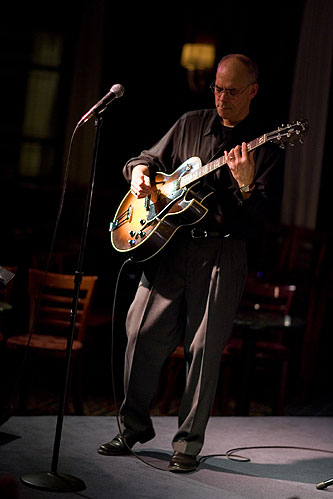 mwe3: Can
you remember your first guitar or guitars and what types of music
did you practice to develop your technique? Do you still practice
guitar a lot these days or are you mostly writing music?
mwe3: Can
you remember your first guitar or guitars and what types of music
did you practice to develop your technique? Do you still practice
guitar a lot these days or are you mostly writing music?
JS: I’ve loved guitars since I was 7 years old. I have way too
many right now, and I’ve owned a lot more guitars over the years
that I’ve passed on to others. I’m not a collector of guitars,
actually, although you might think so if you could see all the guitar
cases stacked up in the corners of my room. My obsession with guitars
is tied into my growth as a musician. I think one of the aspects of
development as a mature musician is learning how to cultivate a unique
personal sound. Since the guitar is my tool of choice to produce musical
sound, I have experimented with many instruments as I refine my understanding
of tone and touch.
I started at a very young age on a beginner guitar and after a few
years my parents gave me a quality instrument, a Goya classical guitar.
When I became a teenager I joined a rock band and I got an electric
guitar. It wasn’t a typical guitar for a rock musician. My grandfather
knew someone who sold instruments and arranged it for me. It was a
blonde 1959 Gibson ES 175 guitar. I have a promo picture for my high
school rock band, and there I am holding that beautiful instrument.
Unfortunately, I sold it when the rock band fizzled. All I have left
now to remember that guitar is the picture.
I guess the 175 started me on my lifetime fascination with Gibson
guitars. It also helped that most of my jazz guitar idols played Gibsons.
Although I’ve owned and loved Martins and Fenders, I would have
to say I am a dyed-in-the-wool Gibson person.
I do practice guitar – as often as I possibly can. It is the
most engaging and enjoyable activity for me. If I could arrange it,
I would practice even more, but life’s responsibilities tend
to present obstacles. I write music in fits. I can get into a mode
of writing tunes and come up with a batch of new compositions, but
I can also go months at a time without writing. I never stop playing
guitar, though. It’s my favorite activity, and it is a rare day
that I don’t play quite a bit.
mwe3: Who were some of your big guitar influences growing up and how
did you try to emulate your heroes and also develop your own style?
JS: Since I’ve been a musician most of my life, I have had an
opportunity to play many styles of music and my musical interests
have been fairly broad. When my career path became clear and I decided
to do music in a serious way, I gravitated to the type of music that
provides me with the most challenge and inspiration – jazz. I
enjoy other types of music but rarely accept gigs in other contexts.
I do have a number of musical heroes, and not just guitarists. The
fact is, I love thinking about music and I love the challenge of trying
to improve myself. I learn tunes. I learn solos that other great musicians
have played. I analyze the work of other musicians, their compositions.
I study types of music, and the great players and composers in each
style. I study the great instrumentalists on all the different instruments,
not just the guitar. I read biographies and autobiographies of great
musicians. I read about the historical periods of jazz music. I hang
out with musicians as much as possible and try to learn whatever they
can teach me.
Of course, I also work specifically on guitar technique –
scales, chord voicings and so forth. Since I play guitar myself, I
have probably listened more to guitarists than anyone else. The most
influential guitarists for me – my two personal guitar heroes
– are Wes Montgomery and Jim Hall. I love these musicians’
unique personal styles and I have always tried to take from each the
elements that I most enjoy, incorporating them into my own style.
I love Wes’ lyrical melodic sense, his phrasing and rhythmic
grace. I never got to meet Wes, he passed way too early, but he touched
me deeply.
I think I’ve learned the most about how to play in a jazz group
from listening to Jim Hall interact with his musical partners. I have
been inspired by his intros and endings, the color notes in his voicings,
his comping sensitivity, and his guitar sound. I love Jim's collaborations
with Paul Desmond, Art Farmer, Sonny Rollins, Bill Evans, Ron Carter,
Red Mitchell, and many others. I feel fortunate to have a small personal
relationship with him.
In the final analysis, what matters is the extent to which I can absorb
and internalize all my studying, so that when I make music I can most
truly express who I am as a human being. I really can’t sound
like any of my heroes, because they are all unique and special musicians.
I’m just doing my best to use what I am learning in order to
express myself.
mwe3: When did you decide to become a recording artist and how did
you overcome your obstacles to reach your high level of musicianship?
JS: Recording for me serves a dual purpose. First of all, it documents
my artistic development at a given stage of my career. I have recorded
10 CDs as a leader so far. I treasure each recording. In every instance,
I produced the most excellent product that I knew how to create at
that moment, so each represents my cumulative knowledge at a specific
moment of time. And because the effort is cumulative, each successive
CD contains more information and represents some kind of growth. This
is not to say that every successive CD is qualitatively better than
previous ones, only that I had more skill and awareness each time
and tried to use it to make a better recording.
The other benefit I receive from recording is that preparing for a
recording provides wonderful focus for my artistic efforts. I compose
music for the session with the specific musicians in mind. I scour
my music library for tunes that I love enough to invest effort into
devising unique arrangements. I am also a democratic band leader and
allow my collaborators to have a lot of input into the arrangements.
This means that often, when the ideas come from the others, I am not
in a comfort zone and I have to really stretch to keep up with their
virtuosity. I think the collaborative nature of my recent recordings
has really pushed them forward and made them more special.
mwe3: Your 2011 album Hi Fly is your best album yet. Any cool
story behind the album and how long have you known and how did you
meet up with your current group featuring keyboardist Jake Sherman,
John Lockwood on bass and Ze on drums? How would you describe the
chemistry between you and your band?
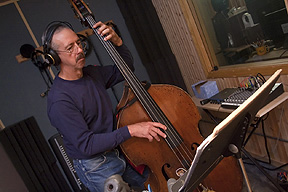 JS:
Once again, I’m really pleased that you like the CD. Hi Fly
is the third in a series of quartet statements. I recorded Encounterpoint
in 2007, Raising The Roof in 2009, and Hi Fly in 2011.
John Lockwood plays bass and Zé Eduardo Nazario plays drums
on all three. The first 2 recordings have a wonderful Japanese pianist
named Koichi Sato, while the newest CD uses Bostonian Jake Sherman.
So only the piano chair has changed. We are not a steady working band.
In fact, we generally play a concert just to get an experience on
the bandstand, then head right into the studio to record the CD. Since
this has now happened three times in the past few years, there is
a growing sense of familiarity between John Lockwood, Zé Eduardo
Nazario and myself. Jake Sherman, like Koichi, is another very young,
precocious, and awesome talent. I’m always amazed by guys who
mature as musicians so quickly, and find it easy to hang with older,
very experienced musicians like John, Zé, and myself. Both
Koichi and Jake are exceptional.
JS:
Once again, I’m really pleased that you like the CD. Hi Fly
is the third in a series of quartet statements. I recorded Encounterpoint
in 2007, Raising The Roof in 2009, and Hi Fly in 2011.
John Lockwood plays bass and Zé Eduardo Nazario plays drums
on all three. The first 2 recordings have a wonderful Japanese pianist
named Koichi Sato, while the newest CD uses Bostonian Jake Sherman.
So only the piano chair has changed. We are not a steady working band.
In fact, we generally play a concert just to get an experience on
the bandstand, then head right into the studio to record the CD. Since
this has now happened three times in the past few years, there is
a growing sense of familiarity between John Lockwood, Zé Eduardo
Nazario and myself. Jake Sherman, like Koichi, is another very young,
precocious, and awesome talent. I’m always amazed by guys who
mature as musicians so quickly, and find it easy to hang with older,
very experienced musicians like John, Zé, and myself. Both
Koichi and Jake are exceptional.
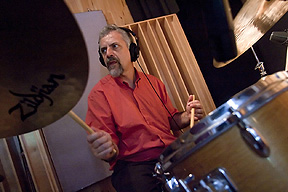 It seems to
me that the most significant growth that has occurred between us throughout
the process of recording these albums is the increasing collaboration.
Many of the arranging concepts come from the other guys – they
are contributing musical ideas, and some of what happens is pretty
spontaneous. For example, we were recording the tune “Love Letters”
for the new CD. I had conceived of it as a fast jazz waltz and we
played it that way throughout the melody statement and the piano solo.
Right when I began to solo, the bass and drums suddenly changed the
time feel and I felt like I was riding a pony that took the bit in
its mouth and galloped off. John Lockwood and Zé launched into
a blistering 4/4 and I grabbed the pony’s mane and held on for
dear life. When I listen to that song, I’m proud of what I managed
to accomplish, but it sure took me by surprise in the moment.
It seems to
me that the most significant growth that has occurred between us throughout
the process of recording these albums is the increasing collaboration.
Many of the arranging concepts come from the other guys – they
are contributing musical ideas, and some of what happens is pretty
spontaneous. For example, we were recording the tune “Love Letters”
for the new CD. I had conceived of it as a fast jazz waltz and we
played it that way throughout the melody statement and the piano solo.
Right when I began to solo, the bass and drums suddenly changed the
time feel and I felt like I was riding a pony that took the bit in
its mouth and galloped off. John Lockwood and Zé launched into
a blistering 4/4 and I grabbed the pony’s mane and held on for
dear life. When I listen to that song, I’m proud of what I managed
to accomplish, but it sure took me by surprise in the moment.
mwe3: What guitars do you perform on Hi Fly and what amps and
guitar effects do you utilize live and in the studio? What are some
of your other favorite guitars?
JS: I think that I sound more or less the same on my recordings. That’s
interesting since I have recorded with many different instruments
and different amps. I think it points out that I have a fairly clear
picture of the sound I love, and manage to use various different pieces
of equipment to achieve my sound.
The guitar I used on Encounterpoint was a 1961 ES 330. I liked
that guitar so much that when the Gibson Custom Shop began to offer
a reissue of the ES 330 a few years ago I bought one. I love the guitar,
although I virtually exchanged all the important parts. I bought a
60’s trapeze tailpiece on eBay to get rid of irritating rattles
in the one that came on the guitar. I changed the P90 pickup in the
neck position to a Lindy Fralin humbucking P90. I never use the bridge
pickup, so I didn’t bother to change it. Although I really enjoyed
the sound of the single coil Gibson P90, in certain situations it
was just way too noisy so I opted for the humbucker. I changed the
nut, the bridge. All that I left untouched was the wood. It is now
a superb guitar and I played it on both Raising The Roof and
Hi Fly. I have a high quality lightweight flight case that
fits the guitar so I use it exclusively when I travel.
Recently I discovered and purchased a 1962 Epiphone Broadway and have
fallen in love with it. Epiphone was Gibson’s only serious factory
jazz-guitar competitor and early Epiphones are fantastic instruments.
By the 50’s Epiphone was on the ropes, going bankrupt, and in
the late 50’s Gibson acquired their name, their fixtures, their
equipment, and all their leftover parts. Gibson began manufacturing
Epiphone guitars and did so throughout the 60’s from a building
right around the corner from their regular factory in Kalamazoo, Michigan.
Gibson-made Epiphones from the 60’s are essentially the same
quality as Gibsons from that era, the only differences being the name
on the headstock, and some design idiosyncrasies regarding body shapes
and sizes. Current Epiphones are budget guitars manufactured overseas,
but my Epiphone Broadway is a killer guitar, and right now my absolute
favorite.
I have two other exceptional instruments: a 1957 ES 175, with a single
humbucking pickup. 1957 was the year Gibson first started putting
humbucking pickups in their guitars, so mine has one of the very first
humbuckers, the famous PAF.
I also have a 1953 ES 350, which is a full depth 17” archtop.
It is pretty rare because this model was made in smaller quantities
and for a limited number of years. In 1956 the ES 350 model was changed
to a thin-bodied guitar with a short scale neck, a different beast
altogether.
I use two amps. My favorite for gigging is an AER Compact 60. It is
a German amp that is incredibly small and light weight, sounds really
good, and can handle nearly any normal gigging situation.
My recording amp is an Acoustic Image Corus. It’s also small
and lightweight, just a bit bulkier to carry around so I reserve it
for special occasions. It gets closest to the tone I love when it
amplifies my guitar – very transparent and warm, and it sings.
I never use any effects beyond a small taste of reverb. I simply plug
in the guitar and play.
mwe3: When you write music, what is your train of thought and can
you say something about your original compositions on the Hi Fly
album?
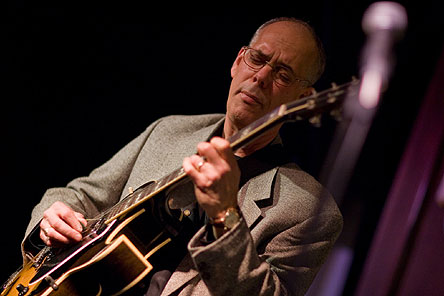 JS: One
of my favorite periods in jazz music history begins in the 50’s
and extends through the 60’s into the 70’s. Those years
were the heyday of Blue Note Records. Many of the classic jazz recordings
were done by that label and nearly all the great jazz musicians of
that era had some kind of affiliation with Blue Note. Many of the
musicians who participated in those recording sessions created and
recorded original jazz compositions. So I have always had a model
in which it is important to contribute original compositions to jazz
recordings. Additionally, I have spent years studying the Harmony
curriculum at Berklee College of Music and it is useful to both analyze
the tunes of others and to compose one’s own tunes. I have the
knowledge necessary to compose my own music and the inspiration to
do so.
JS: One
of my favorite periods in jazz music history begins in the 50’s
and extends through the 60’s into the 70’s. Those years
were the heyday of Blue Note Records. Many of the classic jazz recordings
were done by that label and nearly all the great jazz musicians of
that era had some kind of affiliation with Blue Note. Many of the
musicians who participated in those recording sessions created and
recorded original jazz compositions. So I have always had a model
in which it is important to contribute original compositions to jazz
recordings. Additionally, I have spent years studying the Harmony
curriculum at Berklee College of Music and it is useful to both analyze
the tunes of others and to compose one’s own tunes. I have the
knowledge necessary to compose my own music and the inspiration to
do so.
As I said in response to one of your earlier questions, I go through
periods when I compose more than others, but all my recordings contain
at least some original tunes. Hi Fly is half and half. I’m
very proud of my compositional contributions to this recording. The
tunes are stylistically wide-ranging – from funky mainstream
to modal modern.
Because I like to write and believe strongly in it, I have authored
a couple of books designed to help jazz musicians compose music for
their own performances. I have been writing columns for Just Jazz
Guitar magazine for a number of years and I compiled the educational
materials into two books that are now available. One book concentrates
on writing blues tunes and the other concentrates on writing standard
songs and jazz tunes. Each book includes a CD featuring performances
of the musical examples. I wanted to provide an opportunity for people
to learn some of my tunes, and also help them learn to compose their
own.
mwe3: How about cover tracks here? Can you say something about how
you chose the cover material you and your group perform here? For
instance I didn’t know that Kurt Weil wrote the lead off track
“Speak Low”. How about that one and what do you look for
in a cover?
JS: I always try to arrange a standard tune in a unique way. A tune
is a standard because people like it and use it often. Some of the
great standard tunes have probably been covered a thousand times and
the last thing the world needs is another run-of-the-mill version.
My drummer, Zé Eduardo Nazario, is from Brazil and he has an
encyclopedic knowledge of North American jazz and Brazilian rhythmic
styles. He helps me come up with interesting treatments that juxtapose
North and South American musical styles—like the creative arrangement
of “Hi Fly,” the title track of the new CD. I also look
for tunes that are really nice, but somehow overlooked. It’s
great to remind people of quality songs that fly below the radar.
“Lazy Afternoon” is an example of that. My favorite version
of “Speak Low” is a collaboration between Ella Fitzgerald
and Joe Pass, a gentle duet. Our rendition is certainly quite different!
The only absolute for me when I choose repertoire is that I actually
love the song. I respond emotionally to music, and if a song doesn’t
reach me emotionally it doesn’t interest me.
 mwe3:
What was it like working with sound expert Peter Kontrimas and what
did he contribute to the album?
mwe3:
What was it like working with sound expert Peter Kontrimas and what
did he contribute to the album?
JS: Peter Kontrimas does much of the jazz recording in the Boston
area. His studio is well-designed, with flexible space to accommodate
different musical situations, orderly, his equipment is good. He is
the only person who works there, so he knows every cable, headphone,
microphone, etc. It’s important that the engineer know the studio
and its equipment well. Additionally, Peter is one of Boston’s
finest acoustic bassists, he has great ears and really understands
the music. Every time I return to his studio he seems more attuned
to the process, and has fine-tuned his equipment and his methods to
produce better results.
We play and capture the music in 2 days of recording. Then I return
to the studio and sit with Peter, making a host of decisions to polish
and blend the music into its final form. Selecting the takes, mixing,
and mastering typically requires more time than the actual music-making
sessions. There are so many decisions—where to put each instrument
in the stereo spectrum, how to tonally shape the sound of each instrument,
how loud in relation to the others, it’s a fascinating process.
We start with the drums. My drummer is a Zildjian cymbal endorser
and when he comes up from Brazil we visit the Zildjian factory located
in Norwell south of Boston to select cymbals for use on the recording.
When Peter and I begin mixing we spread the cymbals around in the
stereo spectrum as if we were sitting on the drum throne and striking
them. It’s such a pleasure to hear Zé’s beautiful
cymbals, and the other parts of his drum set from the drummers vantage
point. We build the music from the drums up, adding the other instruments
to the mix, taking care to place each in a distinct location. Everything
has to blend and yet each instrument must also have a strong individual
presence. It’s quite a process, requiring attention to detail
and great patience.
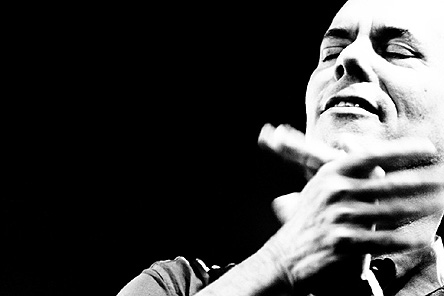 The more
recording experience I have accumulated, the more actively I have
participated in the mixing and mastering process. But ultimately,
the audio quality, clarity, and polish of Hi Fly is
a testament to Peter Kontrimas’ skill.
The more
recording experience I have accumulated, the more actively I have
participated in the mixing and mastering process. But ultimately,
the audio quality, clarity, and polish of Hi Fly is
a testament to Peter Kontrimas’ skill.
mwe3: What’s it like recording on a great label like Whaling
City Sound, headed up by Neal Weiss, and how about your future plans
this year and next?
JS: I recorded my first 5 CDs and released them in a variety of ways
on different labels. It was a learning process regarding the music
business and I took some of the typical lumps that a novice experiences
in a complicated and difficult business environment. Eventually I
met Neal, and now I have a wonderful and supportive partner. He is
located in New Bedord, a port city in Southern Massachusetts where
the whaling industry was once centered—hence the label name.
He is always totally respectful and collaborative. He finds people
whom he admires and then gives them free reign to be creative, not
interfering with their artistic process—a wonderful administrative
style. He always puts quality first, he believes in promotion, never
cuts corners. His label to date has released a little more than 50
CDs, so he is building a substantial independent catalogue of quality
releases.
Neal also thinks ahead. The new CD Hi Fly was recorded last
February and is finally being released now, in September. It takes
many months to bring a project like this to fruition. In order to
stay on a roll, Neal is supporting me to return to Peter Kontrimas’
studio this coming November to record another CD so that we will have
a follow-up ready when Hi Fly has had its day. I’m practicing
the music on Hi Fly now so I can present it to
people this fall in several CD release concerts, and simultaneously
preparing music for the fourth recording in my quartet series. Neal
has become as important a collaborator as the members of my band and
my recording engineer. I simply could not do what I do without him.
Robert, thank you for your thoughtful questions and your encouragement
to reply in depth. I really appreciate the platform you have provided
and the opportunity to share my process with your readers.
Thanks to John Stein and Neil Weiss and David
Arruda @ www.WhalingCitySound.com



